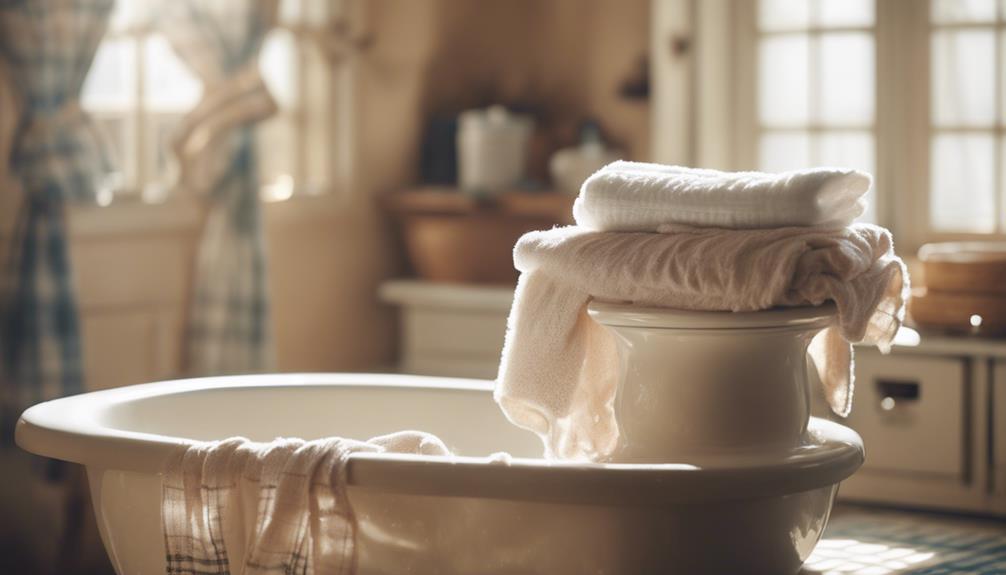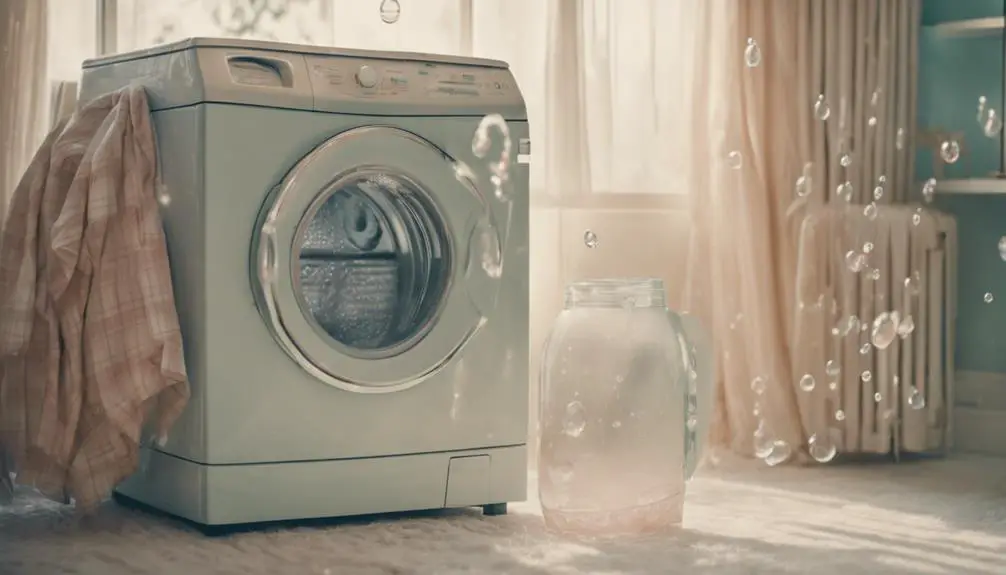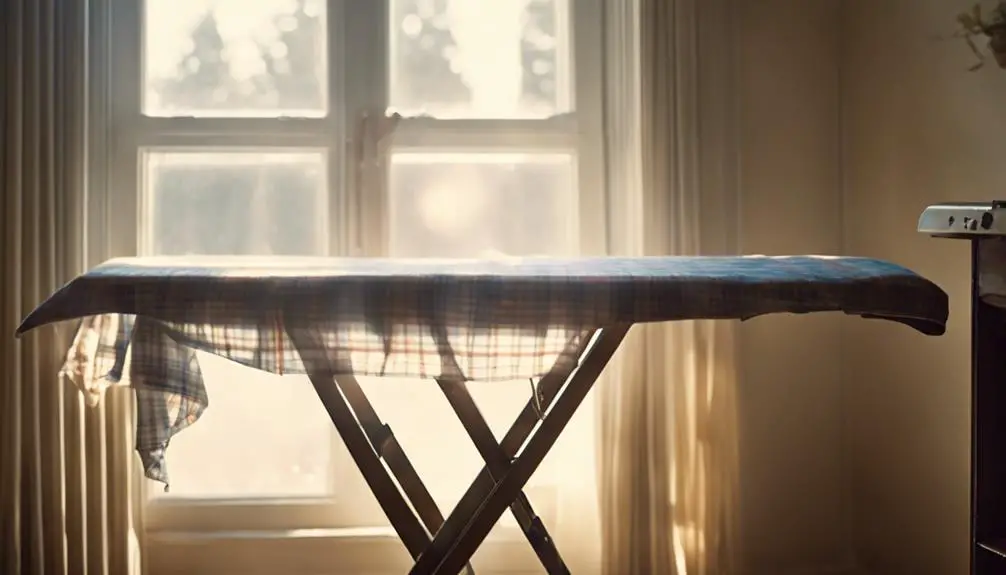To wash a vintage plaid skirt, start by checking the care label for specific instructions. If it allows hand washing, fill a basin with cool water and a mild detergent. Submerge the skirt gently, avoiding any twisting. Let it soak for at least ten minutes, then rinse under cool running water until clear. For drying, lay it flat or hang it away from direct sunlight to prevent distortion. If you're considering machine washing, use a gentle cycle and place it in a laundry bag. Learning the right techniques can truly enhance your vintage wardrobe, so let's explore more details.
Understanding Vintage Fabrics

When it comes to vintage fabrics, understanding their unique characteristics is crucial for proper care. These fabrics often include natural fibers like wool, cotton, and silk, each requiring specific treatment to maintain their integrity and appearance.
Many vintage garments, especially from the mid-century era, are characterized by unique designs and craftsmanship, which can be identified through vintage clothing labels. If you're caring for a vintage pleated skirt, you'll need to pay attention to the fabric's composition. Pre-1950s textiles tend to be more delicate and prone to damage, so avoid modern cleaning methods that could harm them.
Additionally, many vintage items may have unknown dye compositions, making it essential to test for colorfastness before washing. You wouldn't want your beautiful pleated skirt to suffer from dye bleeding, ruining its charm.
The construction techniques, such as pleats or embellishments, also influence cleaning methods. For instance, those intricate pleats must be treated gently to preserve their original shape.
Always check the specific fiber content, whether it's a polyester blend or pure wool, as this dictates the appropriate washing and drying techniques you should use.
Checking Care Labels
After grasping the nuances of vintage fabrics, the next step is to check the care labels on your plaid skirt.
These care labels are your guide to understanding how to properly care for your vintage clothing and can often indicate the era of the garment vintage label history. They might reveal whether your skirt is "dry clean only" or suitable for hand washing. If you see "dry clean only," it's essential to heed that advice; ignoring it could lead to irreversible damage.
Sometimes, vintage items lack care tags entirely, either due to previous removal or hand sewing. In such cases, you'll need to exercise extra caution.
Reflect on any past washing mishaps to inform your current approach. If you've encountered issues with similar materials before, let those experiences guide your decisions now.
Familiarizing yourself with the information on care tags not only helps you maintain your skirt's integrity but also empowers you to make informed choices about cleaning methods.
Preparing for Hand Washing

Before diving into the hand-washing process, it's vital to gather everything you need for a successful wash. Start by checking the care tag on your vintage plaid skirt for specific washing instructions. Some skirts might be labeled "dry clean only," and ignoring this could lead to irreversible damage.
If your skirt is from a well-known brand like Betty Barclay, be particularly cautious, as vintage items often require extra care to maintain their quality.
Next, sort the skirt with similar colors to prevent color bleeding. Create separate piles for lights and darks to keep your vintage clothes looking vibrant.
Once sorted, prepare a suitable soaking container. A clean sink works for single items, while a tub is ideal for multiple skirts.
Now, gather a mild detergent that's gentle on fabrics. Avoid harsh chemicals, as they can fade or damage the delicate fibers of your vintage clothing.
Fill your container with cool or lukewarm water and confirm the detergent is fully dissolved before immersing the skirt. This gentle environment is vital for preserving the integrity of your vintage piece.
With everything ready, you'll be all set to start the hand-washing process, guaranteeing your beloved skirt maintains its charm and quality for years to come.
Hand Washing Techniques
To guarantee your vintage plaid skirt is gently cleaned without damage, start by filling a basin with cold or lukewarm water and adding a mild detergent.
Make certain the detergent fully dissolves before you submerge the skirt. Gently agitate the water to create suds, then immerse your skirt, remembering to avoid any twisting or wringing, as this can harm the delicate fabric.
Allow your vintage skirt to soak for at least ten minutes. This soaking time helps loosen any dirt or stains.
After soaking, rinse it under running water until the water runs clear; you might need to repeat this step a couple of times to guarantee all detergent is removed.
Once rinsed, lay the skirt flat or hang it to dry, carefully aligning the pleats to maintain their shape.
Avoid direct sunlight to prevent fading. If you notice any wrinkles after drying, use steaming for wrinkle removal.
If you choose to iron, test on low heat and always place a protective layer between the iron and your fabric.
Machine Washing Considerations

When it comes to washing your vintage plaid skirt in a machine, it's vital to heed the care label instructions, as some skirts may require hand washing or professional dry cleaning to preserve their unique fabric.
If your skirt is machine washable, you'll want to take a few precautions to keep it looking fabulous. Start by selecting a gentle cycle on your washing machine; this minimizes agitation and protects the delicate pleats and fabric structure.
To further safeguard your skirt, place it in a laundry bag. This simple step prevents snagging and helps maintain its shape during the wash. Always opt for cold water, as it prevents shrinkage and fading, important for vintage fabrics that can be more delicate.
Be mindful not to overcrowd the washing machine. Overloading can crush and distort the pleats, leading to irreversible damage. By allowing plenty of space, you make sure your skirt receives the care it deserves.
Following these guidelines will help your vintage plaid skirt retain its charm and elegance for years to come, making those special pieces even more enjoyable to wear.
Drying Methods
Air drying is the best choice for preserving the beauty of your vintage plaid skirt. This method helps prevent shrinkage and maintains the fabric's integrity, allowing your garment to keep its shape and structure.
If your skirt is non-stretchy, hang it on a hanger or clothesline to drip dry. For stretchy fabrics, lay it flat on a drying rack to avoid distortion.
To speed up the drying process, you can place the skirt between towels to absorb excess moisture before hanging it up. This technique promotes quicker drying without risking damage to the delicate fabric.
Make certain to hang the skirt in its natural shape, as this will help maintain pleats and prevent any unwanted creasing.
Always verify that your skirt is completely dry before moving on to ironing. This step is essential to prevent mildew and maintain fabric quality.
When you're ready to iron, use a low heat setting to protect the delicate fibers. By following these drying methods, you'll keep your vintage plaid skirt looking fresh and vibrant for years to come, guaranteeing it remains a cherished piece in your clothing collection.
Ironing and Finishing Touches

How can you guarantee your vintage plaid skirt looks its best after washing? Start by making sure it's completely dry. Ironing damp fabric can lead to mildew, ruining those beautiful fibers.
Once dry, grab a pressing cloth, like an old t-shirt, to shield the delicate fabric from direct heat. Set your iron to a low temperature that suits the fabric blend—always check the care label for guidance.
When you're ready, carefully iron along the pleats, following their natural lines. This will help retain the skirt's shape and prevent any distortion. Take your time, allowing each section to get the attention it deserves.
After you've finished ironing, hang the skirt in your closet. This storage method not only preserves its pleat structure but also keeps it wrinkle-free, ready for your next outing.
Vintage pieces deserve this extra care, ensuring they remain timeless and stylish for years to come. Proper ironing and finishing touches can elevate your vintage plaid skirt, making it a standout addition to your wardrobe. Enjoy the beauty of your refreshed skirt!
Maintaining Pleat Structure
After you've taken the time to iron your vintage plaid skirt and appreciate its beauty, maintaining that pleat structure during washing is key.
You'll want to make sure those lovely pleats stay crisp and defined, so follow these steps for the best results.
- Tack each pleat in place with temporary threads before washing to hold their shape.
- Use a leg of an old pair of tights in the washing machine to keep pleats tidy and prevent crushing.
- When hand washing, gently squeeze out water without twisting or wringing the fabric to avoid distorting the pleats.
- After washing, let the skirt drip dry until it's damp, then carefully iron the pleats with a pressing cloth for added protection and definition.
Frequently Asked Questions
How Do You Wash Vintage Skirts?
To wash vintage skirts, always check care labels first. Hand wash in cool water with mild detergent, or use a gentle machine cycle. Dry flat or hang, ensuring pleats remain aligned and avoiding direct sunlight.
What Is the Best Way to Wash Vintage Clothes?
To wash vintage clothes, check the care tag first. Hand wash in cool water with mild detergent, or use a gentle machine cycle in a laundry bag. Always air dry to preserve fabric integrity and avoid shrinkage.
How Do You Wash a Vintage Beaded Dress?
To wash a vintage beaded dress, always check the care label first. If safe, gently hand wash in cold water with mild detergent, rinse thoroughly, and lay flat to dry, avoiding any twisting or wringing.
How to Wash a Permanent Pleated Skirt?
To wash a permanent pleated skirt, fill a basin with lukewarm water and mild detergent. Submerge gently, avoiding twists. Afterward, drip dry and iron on low with a pressing cloth to maintain those beautiful pleats.




